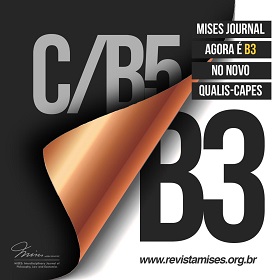Uma teoria praxeológica dos juros
DOI:
https://doi.org/10.30800/mises.2021.v9.1431Palavras-chave:
Teoria dos juros, Praxeologia, História do Pensamento EconômicoResumo
Esse artigo começa pela observação de que a teoria da preferência temporal pura leva a visões conflitantes a respeito do efeito das mudanças na produtividade sobre a taxa de juros. Posteriormente, examina partes da literatura sobre os juros e conclui que a teoria da preferência temporal pura não é uma teoria praxeológica. Então, combina a teoria do juro de Hülsmann com as teorias subjetivistas do capital de Lachmann e Kirzner, gerando uma teoria praxeológica que explica a taxa de juros. A chave dessa teoria é que a redução de custos através do capital fixo deve sempre ser entendida em termos do custo da mão de obra que esse capital substitui. Já que a mão de obra é não específica, e seu preço constitui, em certa medida, os custos de produção de bens de capital fixo, o uso do capital fixo implica necessariamente um excedente empresarial em algum lugar do sistema econômico. Já que o excedente não pode simplesmente desaparecer, qualifica-se como renda de juros. Seu tamanho é tal que a taxa de juros corresponde à taxa marginal de substituição entre mão de obra e capital fixo, tal como se representa nas ações empresariais.
Downloads
Referências
ANTONELLI, E. Le souvenir de Léon Walras et Carl Menger à travers leur correspondence. Economie Appliquée, v. 6, 1953.
BARRO, J. R.; SALA-I-MARTIN, X. Economic Growth. MIT Press, 2004.
BLAUG, M. The formalist revolution of the 1950s. Journal of the History of Economic Thought, v. 25, n. 2, 2003.
BÖHM-BAWERK, E. V. The Positive Theory of Capital. New York: G. E. Stechert and Co., New York, 1930.
BÖHM-BAWERK, E. V. Capital and Interest: A Critical History of Economical Theory. Libertarian Press, South Holland, v. 1, 1959a.
BÖHM-BAWERK, E. V. Capital and Interest: A Critical History of Economical Theory. Libertarian Press, South Holland, v. 2, 1959b.
BÖHM-BAWERK, E. V. Capital and Interest: A Critical History of Economical Theory. Libertarian Press, South Holland, v. 3, 1959c.
BRAUN, M. Finance behind the veil of money. Liberty.me, 2014.
DE SOTO, J. H. Money, Bank Credit, and Economic Cycles. Auburn: Ludwig von Mises Institute, 2009.
ENDRES, M. The origins of Böhm-Bawerk’s greatest error: Theoretical points of separation from Menger. Zeitschrift für die gesamte Staatswissenschaft. Journal of Institutional and Theoretical Economics, p. 143, p. 291–209, 1987.
FETTER, F. A. The principles of economics. The Century Co., New York, 1905.
FETTER, F. A. Interest theories old and new. American Economic Review, v. 4, n. 1, 1914.
FETTER, F. A. Economic principles. The Century Co., New York, 1915.
FETTER, F. A. Capital, Interest, and Rent: Essays in the Theory of Distribution. Kansas City: Sheed Andrew's and McNeel, 1977.
GARRISON, R. Waiting in Vienna. In: Time, Uncertainty, and Disequilibrium, Exploration of Austrian Themes. Lexington, Lexington Books, 1979.
GARRISON, R. Time and Money. The macroeconomics of capital structure. London and New York: Rout-ledge, 2001.
GLORIA-PALERMO, R. The Evolution of Austrian Economics: From Menger to Lachmann. London and New York: Rout-ledge, 1999.
GLORIA-PALERMO, R. In search of the right tool: From formalism to constructivist modelling. GREDEG Working Papers Series, v. 33, 2013.
HAYEK, F. A. Prices and Production. Routledge: London, 1935.
HERBENER, J. M. Introduction. In: The Pure Time-Preference Theory of Interest. Auburn: Ludwig-von-Mises Institute, 2011.
HOLCOMBE, R. G. Entrepreneurship and economic growth. Quarterly Journal of Austrian Economics, v. 1, n. 2, p. 45–62, 1998.
HÜLSMANN, J. G. A theory of interest. Quarterly Journal of Austrian Economics, v. 5, n. 4, 2002.
KALECKI, M. Macrodynamic theory of business cycles. Econometrica, v. 3, p. 327–244, 1935.
KIRZNER I. K. An Essay on Capital. New York: Augustus M. Kelley, 1966.
KIRZNER I. K. The pure time-preference theory of interest: An attempt at clarification. In: J. M. The Pure Time-Preference Theory of Interest. Auburn: Ludwig-von-Mises Institute, [1993] 2011.
LACHMANN, L. M. Capital and its Structure. Kansas City: Sheed Andrew's and McNeel, 1978.
LEWIN, C. Capital in disequilibrium. Auburn: Ludwig von Mises Institute, 2011.
MENGER, C. Grundsätze der Volkswirtschaftslehre. Wien: Wilhelm Braumüller, 1871.
MENGER, C. Principles of Economics. Glencoe: The Free Press, [1871] 1950.
MENGER, C. Problems of Economics and Sociology. Illinois: Urbana, [1883] 1963.
MENGER, C. Principles of Economics. Auburn: Ludwig von Mises Institute, [1976] 2007.
MISES, L. V. Human Action. Auburn: Ludwig von Mises Institute, [1949] 2008.
MISES, L. V. The theory of money and credit. Auburn: Ludwig von Mises Institute, 1954.
MOSS, L. The emergence of interest in a pure exchange economy: Notes on a theorem attributed to Ludwig von Mises. In: SPADARO, L. M. New Directions in Austrian economics. Kansas City: Sheed Andrews and McNeel, 1978.
MURPHY, R. P. The Austrian subjectivist theory of interest: An investigation into the history of thought. Quarterly Journal of Austrian Economics, v. 4, n. 1, 2001.
MURPHY, R. P. Unapticipated Intertemporal Change in Theories of Interest. New York: New York University, 2003.
PELLENGAHR I. The Austrian subjectivist theory of interest. Frankfurt am Main: Peter Lang, 1996.
REISMAN, G. Capitalism. Laguna Hills: TJS Books, [1990] 1998.
ROBINSON, J. The accumulation of capital. R. D. Irwin, Homewood, 1956.
ROTHBARD, M. N. Man, Economy, and State with Power and Market. Auburn: Ludwig von Mises Institute, [1962] 2009.
ROTHBARD, M. N. Time preference. In: J. EATWELL et al (eds). The new Palgrave. A Dictionary of Economics. Macmillan, London, 1987.
SCUMPETER, J. A. History of Economic Analysis. Oxford University Press, New York, 1954.
WOODS JR, E. T. Why the greenbackers are wrong. Mises Daily Article. Available at: http://mises.org/daily/6391/Why-the-Greenbackers-Are-Wrong. Acessed: Mar 29 2013.
Downloads
Publicado
Como Citar
Edição
Seção
Licença
Copyright (c) 2021 MISES: Interdisciplinary Journal of Philosophy, Law and Economics

Este trabalho está licenciado sob uma licença Creative Commons Attribution 4.0 International License.

Este periódico está licenciado sob uma Creative Commons Attribution 4.0 International License.



















